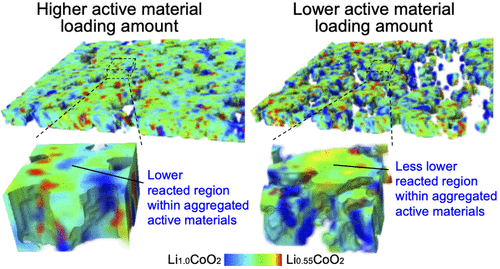当前位置:
X-MOL 学术
›
ACS Appl. Energy Mater.
›
论文详情
Our official English website, www.x-mol.net, welcomes your feedback! (Note: you will need to create a separate account there.)
Influence of Active Material Loading on Electrochemical Reactions in Composite Solid-State Battery Electrodes Revealed by Operando 3D CT-XANES Imaging
ACS Applied Energy Materials ( IF 6.4 ) Pub Date : 2020-07-08 00:00:00 , DOI: 10.1021/acsaem.0c01186 Yuta Kimura 1 , Mahunnop Fakkao 1 , Takashi Nakamura 1 , Toyoki Okumura 2 , Nozomu Ishiguro 1 , Oki Sekizawa 3 , Kiyofumi Nitta 3 , Tomoya Uruga 3 , Mizuki Tada 4 , Yoshiharu Uchimoto 5 , Koji Amezawa 1
ACS Applied Energy Materials ( IF 6.4 ) Pub Date : 2020-07-08 00:00:00 , DOI: 10.1021/acsaem.0c01186 Yuta Kimura 1 , Mahunnop Fakkao 1 , Takashi Nakamura 1 , Toyoki Okumura 2 , Nozomu Ishiguro 1 , Oki Sekizawa 3 , Kiyofumi Nitta 3 , Tomoya Uruga 3 , Mizuki Tada 4 , Yoshiharu Uchimoto 5 , Koji Amezawa 1
Affiliation

|
Designing composite electrodes with optimal microstructure, composition, and choice of active material (AM) as well as solid electrolyte (SE) is critically important for the development of high-performance solid-state batteries (SSBs). To optimize AM loading, which includes loading amount, composition, and dispersion state, and to maximize AM utilization in composite SSB electrodes, we need to precisely understand how the AM loading affects electrochemical reactions taking place in the electrodes. Here, using computed tomography combined with X-ray absorption near edge structure spectroscopy (CT-XANES), we performed operando three-dimensional (3D) observations of electrochemical reactions in composite SSB electrodes with different AM loading amounts to understand the influence of the AM loading on the electrochemical reactions. In the composite electrode with higher AM loading amount, the lower reacted regions were mainly found at the inner parts of the aggregated AM regions. It was suggested that such a reaction distribution resulted from the slow intergranular ion transport between AM particles. In the composite electrode with lower AM loading amount, the electrochemical reaction progressed more homogeneously compared to the one with higher loading. This is probably because the lower AM loading mitigated the AM aggregation and decreased the number of high-resistance AM–AM interfaces that Li ions must pass through. Such a reaction distribution formation due to the slow ion transport between the AM particles can be a serious restriction in composite SSB electrodes. This is in marked contrast to conventional liquid-based lithium ion battery (LIB) electrodes, in which a majority of AM particles can directly exchange Li ions with the surrounding liquid electrolyte. Therefore, the optimal design for composite SSB electrodes can significantly differ from that for liquid-based LIBs. Our analysis technique can provide valuable information to rationally design optimal composite electrodes, and hence we expect that this technique contributes to the further development of high-performance SSBs.
中文翻译:

活性物质负载对Operando 3D CT-XANES成像显示的复合固态电池电极中电化学反应的影响
设计具有最佳微观结构,成分和活性材料(AM)以及固体电解质(SE)的复合电极对于开发高性能固态电池(SSB)至关重要。为了优化AM负载,包括负载量,组成和分散状态,并最大程度地提高复合SSB电极中的AM利用率,我们需要精确地了解AM负载如何影响电极中发生的电化学反应。在这里,我们使用计算机断层扫描技术结合X射线吸收近边缘结构光谱法(CT-XANES),进行了操作在具有不同AM加载量的复合SSB电极中进行电化学反应的三维(3D)观察,以了解AM加载对电化学反应的影响。在AM负载量较高的复合电极中,较低的反应区域主要在聚集的AM区域的内部。有人认为,这种反应分布是由于AM颗粒之间缓慢的晶间离子迁移引起的。在具有较低AM负载量的复合电极中,与较高负载的复合电极相比,电化学反应的进行更为均匀。这可能是因为较低的AM负载减轻了AM聚集,并减少了锂离子必须通过的高电阻AM-AM接口的数量。由于AM颗粒之间离子迁移缓慢而导致的这种反应分布形成可能是复合SSB电极中的严重限制。这与传统的液基锂离子电池(LIB)电极形成鲜明对比,在传统的液基锂离子电池(LIB)电极中,大多数AM颗粒可以与周围的液体电解质直接交换锂离子。因此,复合SSB电极的最佳设计可能与液基LIB的最佳设计大不相同。我们的分析技术可以为合理设计最佳复合电极提供有价值的信息,因此,我们希望该技术有助于高性能SSB的进一步发展。这与传统的液基锂离子电池(LIB)电极形成鲜明对比,在传统的液基锂离子电池(LIB)电极中,大多数AM颗粒可以与周围的液体电解质直接交换锂离子。因此,复合SSB电极的最佳设计可能与液基LIB的最佳设计大不相同。我们的分析技术可以为合理设计最佳复合电极提供有价值的信息,因此,我们希望该技术有助于高性能SSB的进一步发展。这与传统的液基锂离子电池(LIB)电极形成鲜明对比,在传统的液基锂离子电池(LIB)电极中,大多数AM颗粒可以与周围的液体电解质直接交换锂离子。因此,复合SSB电极的最佳设计可能与液基LIB的最佳设计大不相同。我们的分析技术可以为合理设计最佳复合电极提供有价值的信息,因此,我们希望该技术有助于高性能SSB的进一步发展。
更新日期:2020-07-08
中文翻译:

活性物质负载对Operando 3D CT-XANES成像显示的复合固态电池电极中电化学反应的影响
设计具有最佳微观结构,成分和活性材料(AM)以及固体电解质(SE)的复合电极对于开发高性能固态电池(SSB)至关重要。为了优化AM负载,包括负载量,组成和分散状态,并最大程度地提高复合SSB电极中的AM利用率,我们需要精确地了解AM负载如何影响电极中发生的电化学反应。在这里,我们使用计算机断层扫描技术结合X射线吸收近边缘结构光谱法(CT-XANES),进行了操作在具有不同AM加载量的复合SSB电极中进行电化学反应的三维(3D)观察,以了解AM加载对电化学反应的影响。在AM负载量较高的复合电极中,较低的反应区域主要在聚集的AM区域的内部。有人认为,这种反应分布是由于AM颗粒之间缓慢的晶间离子迁移引起的。在具有较低AM负载量的复合电极中,与较高负载的复合电极相比,电化学反应的进行更为均匀。这可能是因为较低的AM负载减轻了AM聚集,并减少了锂离子必须通过的高电阻AM-AM接口的数量。由于AM颗粒之间离子迁移缓慢而导致的这种反应分布形成可能是复合SSB电极中的严重限制。这与传统的液基锂离子电池(LIB)电极形成鲜明对比,在传统的液基锂离子电池(LIB)电极中,大多数AM颗粒可以与周围的液体电解质直接交换锂离子。因此,复合SSB电极的最佳设计可能与液基LIB的最佳设计大不相同。我们的分析技术可以为合理设计最佳复合电极提供有价值的信息,因此,我们希望该技术有助于高性能SSB的进一步发展。这与传统的液基锂离子电池(LIB)电极形成鲜明对比,在传统的液基锂离子电池(LIB)电极中,大多数AM颗粒可以与周围的液体电解质直接交换锂离子。因此,复合SSB电极的最佳设计可能与液基LIB的最佳设计大不相同。我们的分析技术可以为合理设计最佳复合电极提供有价值的信息,因此,我们希望该技术有助于高性能SSB的进一步发展。这与传统的液基锂离子电池(LIB)电极形成鲜明对比,在传统的液基锂离子电池(LIB)电极中,大多数AM颗粒可以与周围的液体电解质直接交换锂离子。因此,复合SSB电极的最佳设计可能与液基LIB的最佳设计大不相同。我们的分析技术可以为合理设计最佳复合电极提供有价值的信息,因此,我们希望该技术有助于高性能SSB的进一步发展。



























 京公网安备 11010802027423号
京公网安备 11010802027423号